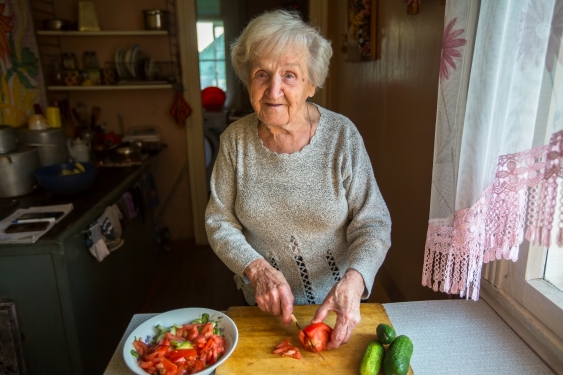Seed funding for new technology to tackle disease
UNSW faculties of Medicine and Engineering are investing nearly $2m in four clincally-led biomedical engineering initatives that will help address major health problems.
UNSW faculties of Medicine and Engineering are investing nearly $2m in four clincally-led biomedical engineering initatives that will help address major health problems.

Four cutting-edge biomedical projects have received seed funding from UNSW Sydney to create technology-based solutions to address widespread health problems.
UNSW faculties of Medicine and Engineering are investing up to $1.8 million on projects that engage clinicians in solving problems that will have a major impact on health issues such as sleep apnoea, keeping the elderly safe in their homes, improving medical image analysis and guiding radiotherapy treatments for cancer patients.
This is the first time UNSW has offered this type of partnership and funding for clinically led healthcare solutions that could be utilised by local area health districts.
The projects involve UNSW’s collaboration with Prince of Wales Hospital, Ingham Institute, Liverpool and Macarthur Cancer Therapy Centres and the CSIRO, with the aim for funding to lead to clinical trials and commercialisation of the four initiatives.
“Biomedical engineering is one of the most dynamic and fast-growing fields,” says Mark Hoffman, UNSW’s Dean of Engineering. “The Biomedical Engineering Seed Fund, created with Rodney Phillips, UNSW’s Dean of Medicine, is unique in that it’s clinically-led, supporting initiatives that pair a clinician with an engineering researcher on real-world problems where projects could have an immediate impact on health issues.”
A new monitoring technology to help people with early dementia live safely at home for longer is one of the projects being developed by Professor Branko Celler, from the School of Electrical Engineering and Telecommunications.

“More than 410,000 people in Australia have dementia, with about 70,000 living alone,” says Professor Celler. “What we want to create is a low-cost, adaptable at-home technology device that can prolong the period of time someone with dementia can continue living independently.”
Working with a clinical care team, a virtual assistant system will be set up in the patient’s home with miniature speakers in each room that talk and instruct the person on daily and weekly tasks.
“It will be like Google Assistant and use minimal kit or gear in the home, with a visual display to help reinforce the audio-messages. The patient will also wear a fall detection monitor that will alert the care team to a fall, a drop in energy levels or sleep patterns,” says Professor Celler. “A metric we are developing will then guide healthcare providers on when it is no longer safe to stay at home.”
Professor Celler is currently working with community nurses and Alzheimer’s clinicians to identify existing and new technology that can be used in a clinical trial setting
“At-home telemonitoring is crucial for reducing expenditure on medical services, hospital admissions and the burden on the health system,” he says.
In another project, Professor Lynne Bilston, from UNSW Medicine and Neuroscience Research Australia (NeuRA), in collaboration with researchers from the Graduate School of Biomedical Engineering, is developing a novel treatment device for obstructive sleep apnoea.
“New treatments for sleep apnoea are urgently needed,” says Professor Bilston. “Many patients cannot tolerate the current clunky and uncomfortable ‘gold standard’ treatment, Continuous Positive Airway Pressure (CPAP). Other treatments are not effective for all patients.”
Sleep apnoea is an increasingly common sleep disorder that affects more than 9% of Australian adults. In sleep apnoea patients, the throat can collapse many times an hour, causing the patient to stop breathing repeatedly during the night. It results in excessive daytime sleepiness, increased risk of accidents, and cardiovascular disease.
Professor Bilston says that by developing and testing a new device to stimulate the muscles around the throat, “we can prevent the collapse of the upper airway that occurs during sleep in sleep apnoea patients.”
Other projects include Professor Alec Welsh’s work to improve 3D ultrasound medical image analysis tools in order to quantify available data using new applications and Associate Professor Lois Holloway’s development of radiotherapy software tools for patients suffering from prostate, lung and breast cancer. Professor Holloway plans to develop a methodology to show how radiotherapy treatments should change based on outcomes of data and adapting as new data becomes available.
The four biomedical seed fund projects are:
Smart home IT support for frail elderly people with early dementia who live alone, led by Professor Branko Celler from the School of Electrical Engineering, Scientia Professor Henry Brodaty from the Centre for Healthy Brain Ageing (CHeBA), A/Prof Stephen Redmond from the Graduate School of Biomedical Engineering and Associate Professor Kim Delbaere from NeuRA.
A novel optical stimulation method for Obstructive Sleep Apnoea treatment, led by Professor Lynne Bilston from NeuRA and UNSW Medicine, and Scientia Professor Nigel Lovell from the Graduate School of Biomedical Engineering.
Development of a modular medical image analysis application (MIAA), led by Professor Alec Welsh from the School of Women’s and Children’s Health and Assocaite Professor Tracie Barber from the School of Mechanical and Manufacturing Engineering.
Learning from and Improving target volume delineation in radiotherapy, led by Associate Professor Lois Holloway, Ingham Institute, South Western Sydney Clinical School and Professor Arcot Sowmya from the School of Computer Science and Engineering.
The projects will be funded for three years.